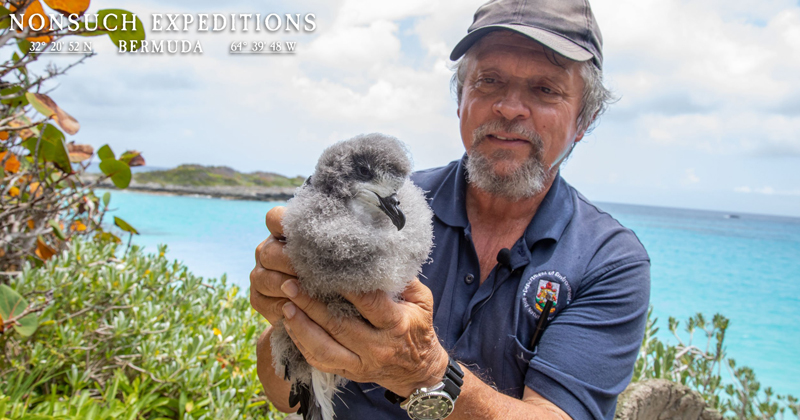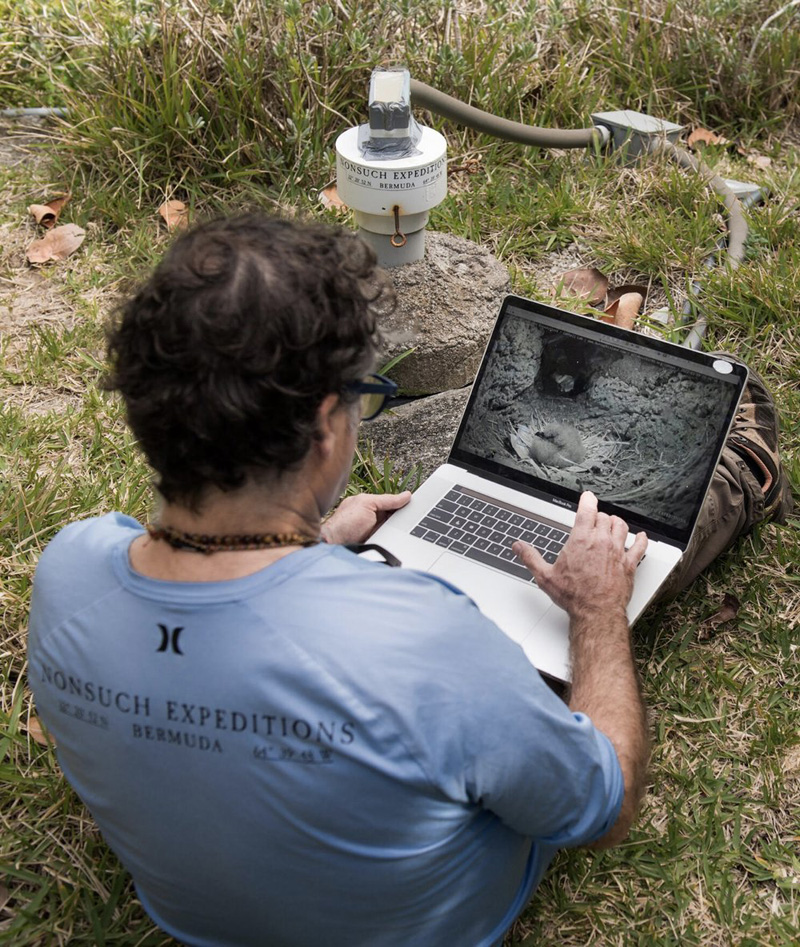Cahow Fledging Season Begins On Nonsuch
Cahow fledging season is beginning on Nonsuch Island, with a “record number of birds for the Cahow Recovery Project.”
Jeremy Madeiros, principal conservationist for the Cahow recovery project, said, “From only 18 breeding pairs, making up the entire population of the Cahow when the program began in the early 1960s, the Cahow population has now grown to a record number of 155 breeding pairs, up from 143 pairs in 2021. In addition, we can now confirm that there are a record number of chicks this year – 77 – compared to the previous record of 73 chicks in 2019.”
The spokesperson said, “The chicks are fledging [take their first flight and heading out to sea] from now until mid June, having been fattened up by their parents since they hatched in February and March.
“The critically endangered Bermuda Petrel, or Cahow [Pterodroma cahow], Bermuda’s national bird, is a football-sized fuzzball [until it sheds its down prior to fledging] with a wingspan of 35-36 inches when ready to fly.
“When cahows fledge from Nonsuch, it is suspected they will not touch solid ground again for 3-5 years, wandering over the open ocean in there North Atlantic, feeding on squid, small fish, and crustaceans, and sleeping on the wing.”
Mr. Madeiros, “The oldest of this year’s cohort of chicks have just begun their pre-fledging exercise period, coming out of their underground burrows at night to exercise, strengthen their flight muscles, and imprinting on the area surrounding their nest. In their first flight, they will head straight out to sea.
“This imprinting is instrumental in enabling them to eventually make their way back to the same location, several years from now. Remote Nonsuch Island, and the neighboring islands and rocks total less than 22 acres on the southeast coast of Bermuda, and is the only place on Earth where the Cahow nests.”
The spokesperson said, “The 60-year-running Cahow Recovery Project controls and manages threats to the Cahow on the breeding islands, and has enabled the species to recover from near-extinction. The incredible seabird was thought to be extinct for 300+ years until it was rediscovered nesting in a few remote Castle Harbour islets in 1951, by a team that included a young David Wingate – who was later appointed Bermuda’s first Conservation Officer in order to facilitate their recovery on Nonsuch in the 1960s.
“Cahows were wiped out on Nonsuch Island and all the larger Islands of Bermuda by the 1620s due to introduced mammal predators such as rats, cats, dogs, and hogs, and hunting by the early settlers.
“Two separate translocation projects, carried out in 2004-2008 and 2013-2017, succeeded in re-establishing two new nesting colonies [A&B] in different locations on Nonsuch.
“These colonies have been so successful that since 2009, when the first returning pair produced a chick on Nonsuch for the first time in 300 years, the Nonsuch colonies have increased to a total of 31 nesting pairs, producing a record number of 16 chicks in 2022.”
Mr. Madeiros said, “Throughout the entire colony, from only 18 breeding pairs, which made up the entire population of the Cahow when the program began in the early 1960s after their remarkable re-discovery in 1951, the Cahow population has now grown to a record number of 155 breeding pairs, up from 143 pairs in 2021. In addition, we can now confirm that there are a record number of chicks this year – 77 – compared to the previous record of 73 chicks in 2019.”
On March of 2022 Rouja logs into the latest generation of CahowCam, now buried underground on the side of burrow #831 – viewing the birds without ever having to remove the lid of their artificial burrow
The spokesperson said, “The Cahow Recovery Project has been able to garner huge amounts of data and insight into the behaviour of the birds on land, in a large part with the help of the CahowCam, an innovation of Nonsuch Expeditions Founder and conservation tech developer Jean-Pierre Rouja. The CahowCam broadcasts the activities of the endangered birds from within their underground nesting burrows.
“It consists of a camera embedded into a PVC pipe above the nest for easy maintenance, surrounded by a ring of special LED bulbs, designed to light up the cahow’s activities, but not to be detected by their extremely light-sensitive eyes. The CahowCam recently celebrated its 10-year broadcasting anniversary.
“You can learn more about this conservation tech development, which is paving the way to study other difficult-to-observe target species, here.
“The CahowCam has allowed locals, students, and scientists from around the world to watch the complete breeding cycle of one of the rarest seabirds on the planet – without ever disturbing them.”
Mr. Rouja said, “As in past years, we will be tracking the Cahow chicks using our remotely controlled infrared surface Cam as they spend a few nights wandering around the colony exercising and imprinting on their surroundings prior to fledging, and if all goes well, we will actually witness them launch into their first flight.”
The spokesperson said, “In addition to a record number of chicks, the 2022 breeding season will also see another first – the fitting of a global location sensor [GLS] tag on a juvenile fledgling bird. Up until this point, the Cahow Recovery project has only fitted a handful of GLS tags on adult birds, giving them insight into where the mature birds went between nesting periods – but no one knew what the birds did during the period after they left Nonsuch for the first time, and returned 3-5 years later to make a nest of their own.
“Fitting a fledgling with a small GLS tag will provide positional data on what might be termed the cahow’s ‘lost years’.”
Mr. Madeiros said, “This has never been carried out on fledglings before, and their movements during this vital developmental period are completely unknown. This information will be vital in determining whether they are encountering threats at sea – for example, from industrial fishing activities, or areas on the Canadian continental shelf where oil and gas extraction and exploration are taking place.”
The spokesperson said, “A total of 37 birds will be fitted with GLS tags, provided by research partner Letizia Campioni. The tags record daily positions of the birds for up to 32 months – around the time the tags stop recording, the birds are expected back at Nonsuch. The tags do not transmit data live, but rather archive it – so the Cahow Recovery Project will only be able to see the data after the Cahows return and the tag can be retrieved.”
Mr. Rouja said, “It will be a huge reward after three years of waiting.”
The spokesperson said, “The CahowCam 1 chick, recently named Atlas by Madeiros’ daughter, Elizabeth, was fitted with an identification band and a GLS tag on Wednesday 18th May. You can watch the full video, captured by Rouja, below.
“Atlas is now preparing to fledge – possibly as early as this weekend. You can tune in to watch the chick’s activities here.”
Read More About
Category: All, Environment




